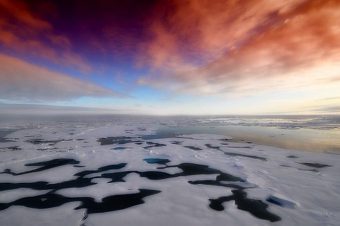
The Arctic winter comes and goes — but ever so differently as warming trends prevail. Increasing temperatures and glacial caving continue as Mother Nature gets hotter — at the top of our world as elsewhere.
James Balog has an immense range of visuals on this subject. Once long ago a skeptic himself, he transformed and has been documenting the loss of our glaciers (see ICE: Portraits of Vanishing Glaciers). Balog has been patiently filming the cavings for years.
A recent update from The Guardian notes that the increasing temperature from recent weather data is worrying the scientists who firmly watch the effects of climate change and know what they could mean for human wellbeing. The report passes along the message that the Arctic region just experienced its warmest winter on record.
“Sea ice hit record lows for the time of year, new US weather data revealed on Tuesday.” The situation reminds me of the old adage about Mother Nature. Mother Nature can’t be fooled, but some of us are foolish about our small planet’s challenges.
“It’s just crazy, crazy stuff,” said Mark Serreze, director of the National Snow and Ice Data Center in Boulder, Colorado, who has been studying the Arctic since 1982. “These heat waves – I’ve never seen anything like this.”
It is unquestionable that the truth is so frightening that some avoid the credible information altogether. Still, day by day, we who read CleanTechnica keep our eyes out for new information and act to turn the trend in a more positive direction. An earlier post (linked above) describes that, in the next 10 or so years, “13 large global cities are facing temperature rises that could exceed 2° degrees Celsius (3.6° Fahrenheit), according to a new report from the Urban Climate Change Research Network at Columbia University.”
The Guardian continues: “Experts say what’s happening is unprecedented, part of a global warming-driven cycle that probably played a role in the recent strong, icy storms in Europe and the north-eastern US.
“The land weather station closest to the North Pole, at the tip of Greenland, spent more than 60 hours above freezing in February. Before this year, scientists had seen the temperature there rise above freezing in February only twice before, and then extremely briefly. Last month’s record-high temperatures have been more like those typical of May, said Ruth Mottram, a climate scientist at the Danish Meteorological Institute.
“Of nearly three dozen different Arctic weather stations, 15 of them were at least 10F (5.6C) above normal for the winter. ‘The extended warmth really has staggered all of us,’ Mottram said.”
Source: cleantechnica.com

